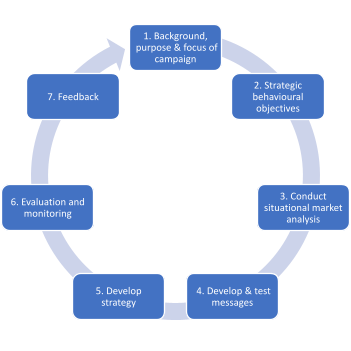Why it matters
Targeted and sustained communication and behaviour change strategies can be used to empower people to improve their salt intake and diet, create consumer demand for lower salt food products, and improve uptake of other salt reduction strategies (e.g. utilise front-of-pack sodium labelling to select lower salt products).
Important areas to raise consumer awareness and enable behaviour change include:
- health risks of excess salt consumption
- major sources of salt (e.g. what foods, from where)
- approaches to lower salt consumption
How to do it
Design the strategy
To develop strategies for education and communication, follow the steps for how to develop a consumer awareness campaign (Tool 1). Seven key steps are:

To do the first three steps, you will need to analyse the data collected from your surveillance and monitoring research actions to understand for example, where are the gaps in salt-related knowledge, what salty behaviours to target, what population subgroups to target interventions towards, and what foods and meals to avoid. For information and resources, go to Surveillance Monitoring & Evaluation section.
Where possible, communication or behaviour change strategies should be grounded by theories or frameworks (Resource 1). An example of a framework used in salt reduction is the Communication for Behavioural Impact (COMBI) framework (Resource 2). A real-world example of its use is in Vietnam’s ‘Eat Less Salt COMBI Strategy’ (Resource 3). COMBI is an integrated marking approach to social mobilization, and include the five integrated communication actions:
- Administrative mobilization and public advocacy
- Community mobilization
- Advertising (M-RIP approach – Massive, Repetitive, Intense, Persistent)
- ‘Personal selling’: the face to face engagement
- Point of service promotion using tools to support interactions
Other theories and frameworks that may be helpful to guide the design of your consumer awareness strategy include:
- Social Marketing (Resource 4)
- Behaviour Change Wheel (Resource 5)
- Theoretical Domains Framework (Resource 6)
- COM-B and TDF combined (Resource 7)
Additionally, it is important to consider how your campaign might complement the other interventions in the salt reduction strategy.
Develop the materials and salt reduction messages
In order to develop different types of materials (e.g. leaflets, digital media, infographics, information booklets) and messages for various channels of communication (television, radio, news and online article), here are some examples:
- Example media releases and recommended format (Tool 2)
- Video “How salty is your kid’s fast food?” (Resource 8)
- Video “Salt: The Hidden Danger – Short Documentary” (Resource 9)
- Video “Salt levels in meat alternatives – ABC News Australia” (Resource 10)